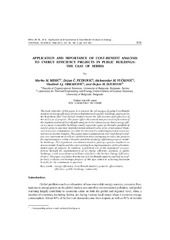Please use this identifier to cite or link to this item:
https://rfos.fon.bg.ac.rs/handle/123456789/873Full metadata record
| DC Field | Value | Language |
|---|---|---|
| dc.creator | Mihić, Marko | |
| dc.creator | Petrović, Dejan | |
| dc.creator | Vučković, Aleksandar M. | |
| dc.creator | Obradović, Vladimir | |
| dc.creator | Đurović, Dejan M. | |
| dc.date.accessioned | 2023-05-12T10:27:17Z | - |
| dc.date.available | 2023-05-12T10:27:17Z | - |
| dc.date.issued | 2012 | |
| dc.identifier.issn | 0354-9836 | |
| dc.identifier.uri | https://rfos.fon.bg.ac.rs/handle/123456789/873 | - |
| dc.description.abstract | The main objective of this paper is to present the advantages of using Cost-Benefit analysis in energy efficiency projects implemented in public buildings, and to prove the hypothesis that Cost-Benefit analysis boosts the effectiveness and efficiency of the said type of projects. The paper offers theoretical and practical explanation of the implementation of Cost-Benefit analysis in the relevant area. Since energy efficiency projects in public buildings usually represent a part of a broader portfolio of similar projects and their implementation demands allocation of substantial financial resources, communities are often be interested in achieving maximal economic and non-economic benefits. This paper aims to demonstrate that Cost-Benefit analysis can represent an excellent contribution when attempting to select the projects for implementation within a broader portfolio of energy efficiency projects in public buildings. This hypothesis was demonstrated by putting a greater emphasis on non-economic benefits and the costs arising from implementation of the aforementioned types of projects. In addition, a practical test of this hypothesis was performed through the implementation of an energy efficiency portfolio in public buildings, worth several tens of millions of dollars - the Serbian Energy Efficiency Project. The paper concludes that the use of Cost-Benefit analysis can help us to effectively evaluate and manage projects of this type aimed at achieving maximum benefits for the community in question. | en |
| dc.publisher | Univerzitet u Beogradu - Institut za nuklearne nauke Vinča, Beograd | |
| dc.relation | info:eu-repo/grantAgreement/MESTD/Basic Research (BR or ON)/179081/RS// | |
| dc.rights | openAccess | |
| dc.rights.uri | https://creativecommons.org/licenses/by-nc-nd/4.0/ | |
| dc.source | Thermal Science | |
| dc.subject | public buildings | en |
| dc.subject | projects | en |
| dc.subject | energy efficiency | en |
| dc.subject | efficiency | en |
| dc.subject | effectiveness | en |
| dc.subject | Cost-Benefit analysis | en |
| dc.subject | community | en |
| dc.title | Application and importance of cost-benefit analysis to energy efficiency projects in public buildings: The case of Serbia | en |
| dc.type | article | |
| dc.rights.license | BY-NC-ND | |
| dc.citation.epage | 929 | |
| dc.citation.issue | 3 | |
| dc.citation.other | 16(3): 915-929 | |
| dc.citation.rank | M23 | |
| dc.citation.spage | 915 | |
| dc.citation.volume | 16 | |
| dc.identifier.doi | 10.2298/TSCI110911090M | |
| dc.identifier.fulltext | http://prototype2.rcub.bg.ac.rs/bitstream/id/1206/869.pdf | |
| dc.identifier.rcub | conv_1006 | |
| dc.identifier.scopus | 2-s2.0-84868368125 | |
| dc.identifier.wos | 000309376200022 | |
| dc.type.version | publishedVersion | |
| item.cerifentitytype | Publications | - |
| item.fulltext | With Fulltext | - |
| item.grantfulltext | open | - |
| item.openairetype | article | - |
| item.openairecristype | http://purl.org/coar/resource_type/c_18cf | - |
| Appears in Collections: | Radovi istraživača / Researchers’ publications | |
This item is licensed under a Creative Commons License


